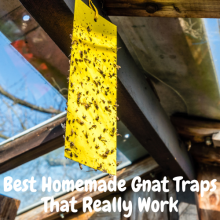Where To Place Gnat Traps For Effective Control | HelpHowTo
Summary of Answering Where To Place Gnat Traps For Effective Control
Controlling gnats requires an effective strategy with proper trap placement being crucial. Understand the various trap types like sticky ribbons, liquid baits, and light traps that use UV to attract insects. Place traps strategically in prime gnat hotspots such as kitchens near sinks and fruit, bathrooms, windows/doors, garbage cans, basements, and outdoor areas like gardens and compost piles.
Consider factors like high gnat traffic, moisture sources, optimal trap height, and airflow when positioning. Rotate trap locations periodically to target new populations and prevent gnats from avoiding traps. While traps are effective, use them as part of an integrated pest management approach including eliminating moisture sources, cleaning up organic matter, and good sanitation practices for comprehensive gnat control.

Our Top 5 Recommended Indoor Genat Traps
Sick of pesky gnats invading your home? Discover the top 5 indoor gnat traps to banish these annoying insects for good! Our expert reviews reveal the most effective, easy-to-use traps. From powerful UV attractants to eco-friendly vinegar traps, we’ve thoroughly tested and ranked the best solutions. Check Now

Best Places To Put Gnat Traps
Dealing with pesky gnats can be a frustrating experience for homeowners. These tiny flying insects seem to appear out of nowhere, swarming around kitchens, bathrooms, and any area with moisture or organic matter. While gnats may seem harmless, their presence can be a nuisance and may indicate a larger pest problem. Implementing an effective gnat control strategy is crucial, and proper trap placement plays a vital role in achieving success.
Understanding The Various Types of Traps
One of the first steps in controlling gnats is understanding the various types of traps available. Sticky ribbons or tapes are a popular option, physically trapping gnats that land on the adhesive surface. While these traps are effective at capturing gnats, they can be unsightly and may need to be replaced frequently. Liquid or bait traps, on the other hand, use attractants like fruit or vinegar to lure gnats into a drowning solution. These traps are generally more discreet but require regular maintenance to replace the bait and solution.
Another type of trap gaining popularity is the light trap, which uses UV light to attract gnats. These traps can be particularly effective for fungus gnats, which are drawn to the light. However, light traps may also attract other insects, and their effectiveness can vary depending on the gnat species.
Choosing The Placement
Once you’ve chosen the appropriate trap type, strategic placement is key to maximizing its effectiveness. Kitchens are a prime target for gnat traps due to the presence of moisture, food sources, and organic matter. Place traps near sinks, drains, and compost bins, as well as around fruit bowls and houseplants. Bathrooms are another hotspot for gnats, with traps being most effective near drains, showers, and tubs, where dampness and organic buildup can occur.
Windows and doors are also important areas to consider, as they serve as entry points for gnats from the outdoors. Placing traps near screens or cracks can help catch gnats before they make their way into your living spaces. Garbage cans, both indoor and outdoor, can be breeding grounds for gnats, so positioning traps on or around these areas is recommended.
Beyond these primary locations, there are several other strategic spots to consider for gnat trap placement. Near houseplants, where gnats may congregate, is one such area. Basements, garages, and pet areas can also be prime gnat habitats and may require targeted trapping. Additionally, outdoor gnat hotspots like gardens, compost piles, or trash cans should be addressed with appropriate trap placement.
Consider The Important Factors
When positioning gnat traps, it’s important to consider factors such as high gnat traffic areas, proximity to moisture sources, and optimal trap height. Avoiding air currents that could disrupt the effectiveness of lures or attractants is also crucial. Furthermore, positioning traps a few inches away from walls or corners can increase airflow and improve their performance.
Rotate Trap Locations Periodically
While trap placement is essential, it’s important to rotate trap locations periodically. This strategy helps target new gnat populations before they become established and prevents gnats from becoming accustomed to the presence of a trap in a particular area. Additionally, regularly checking and replacing traps as needed is crucial for maintaining their effectiveness.
Integrated Pest Management
However, it’s important to note that while traps can be an effective tool in gnat control, they should be used as part of a comprehensive integrated pest management (IPM) approach. Eliminating sources of standing water, promptly cleaning up spills or organic matter, and addressing any underlying moisture issues are essential steps in preventing gnat infestations. Additionally, some trap types may have drawbacks, such as the unsightly appearance of sticky ribbons or the potential for light traps to attract other insects.
Conclusion
In conclusion, controlling gnats in your home requires a multi-faceted approach, with strategic trap placement playing a pivotal role. By understanding the various trap types, identifying key indoor and outdoor areas for placement, following positioning tips, and rotating trap locations regularly, you can maximize the effectiveness of your gnat control efforts. However, it’s essential to complement trapping with good sanitation practices and addressing any underlying conditions that may be attracting gnats. With a comprehensive IPM strategy, you can effectively rid your home of these pesky pests and enjoy a gnat-free living environment.

Our Top 5 Recommended Indoor Genat Traps
Sick of pesky gnats invading your home? Discover the top 5 indoor gnat traps to banish these annoying insects for good! Our expert reviews reveal the most effective, easy-to-use traps. From powerful UV attractants to eco-friendly vinegar traps, we’ve thoroughly tested and ranked the best solutions. Check Now
FAQs and Answers
Is there a recommended distance to place gnat traps from walls or corners beyond just a few inches?
Yes, the optimal height for positioning gnat traps can vary based on the type of trap:
Sticky Ribbon/Tape Traps:
- These should be placed at around eye level or slightly higher
- Generally 5-6 feet off the ground is recommended
- Gnats tend to fly at this height, increasing chances of contact
Liquid/Bait Traps:
- Position these lower, about 2-3 feet from the floor
- The bait odors tend to concentrate lower to the ground
- Gnats are more likely to be lured in at this level
Light Traps:
- Mount these at around 4-5 feet high
- This allows the UV light to disperse well through the room
- But not so high that gnats can’t detect the light easily
Traps placed either too low or too high can reduce their effectiveness. Match the trap type to the natural gnat flight patterns and behavior for maximum efficacy. The proper height positioning is important along with strategic location.
Are there certain heights or levels that are better for positioning different types of gnat traps?
Yes, the optimal height for positioning gnat traps can vary depending on the type of trap being used:
Sticky Ribbon/Tape Traps:
- These should be placed at around eye level or slightly higher, generally around 5-6 feet off the ground.
- Gnats tend to fly at this height, increasing the chances of them coming into contact with the sticky surface.
Liquid/Bait Traps:
- Position these lower, about 2-3 feet from the floor.
- The bait odors tend to concentrate lower to the ground, and gnats are more likely to be lured in at this level by the attractants.
Light Traps:
- Mount these at around 4-5 feet high.
- This height allows the UV light to disperse well through the room, while still being low enough for gnats to detect and be drawn to the light source.
Traps placed either too low or too high can reduce their effectiveness. It’s important to match the trap type to the natural gnat flight patterns and behavior for maximum efficacy. Proper height positioning, along with strategic location, is crucial for optimal gnat trapping.
How often should gnat trap locations be rotated, and what is the ideal rotation pattern?
There are no hard and fast rules on how often to rotate gnat trap locations, but most experts recommend doing so every 1-2 weeks. The reasoning behind regular rotation is two-fold:
- Target new gnat populations: Gnats can quickly establish breeding sites and become accustomed to trap locations. Rotating traps every 1-2 weeks helps catch new gnat populations before they become entrenched.
- Prevent trap acclimatization: If traps remain in the same spots for too long, gnats may start avoiding those areas entirely. Rotation prevents them from getting used to and ignoring the traps.
As for an ideal rotation pattern, a systematic approach works best. For example, if you have 6 traps placed throughout your home:
Week 1: Traps in locations A, B, C, D, E, F
Week 2: Rotate to locations B, C, D, E, F, A
Week 3: Rotate to locations C, D, E, F, A, B
…and so on, moving each trap to a new spot each week.
This allows you to thoroughly cover all potential gnat hotspots and entry points over a cycle of several weeks. Some experts suggest keeping a log to track the rotation sequence.
The rotation frequency of 1-2 weeks is recommended for most homes with typical gnat issues. For more severe infestations, more frequent rotation every 5-7 days may be advisable initially until populations are under better control.
Are there any specific outdoor areas besides gardens and trash cans that are gnat hotspots requiring trap placement?
Yes, there are several other outdoor areas that can be hotspots for gnats requiring strategic trap placement besides gardens and trash cans:
- Compost piles/bins – The decaying organic matter in compost is very attractive to gnats looking to lay eggs. Placing traps around or on top of compost piles can help control populations.
- Standing water sources – Any areas with stagnant water like bird baths, clogged gutters, or poorly drained spots can breed gnats. Strategic trap placement near these sources is recommended.
- Mulched landscaping areas – Damp mulch serves as an ideal breeding ground. Surrounding mulched garden beds with traps can reduce gnats traveling indoors.
- Tree holes/cavities – Rot holes and cavities in trees collect water and organic debris where gnats reproduce. Hanging traps from affected trees catches them before they spread.
- Pet areas – Gnats are drawn to spilled pet food, water bowls, and areas with pet waste accumulation. Applying traps specifically around these spots is wise.
- Trash/recycling areas – Beyond just trash cans themselves, the entire storage area for bins and bags can be a gnat magnet if not kept clean.
- Outdoor kitchen/grilling spaces – Food smells and spills make these areas prime gnat territory in warm months when outdoor cooking increases.
Essentially, anywhere moisture meets organic matter creates ideal gnat breeding conditions outdoors. A comprehensive trap strategy should account for these diverse outdoor hotspots.
Should gnat traps be concentrated in one area or spread out throughout the home/property for best results?
For best results in controlling gnats, it’s generally recommended to spread gnat traps out throughout your home and property rather than concentrating them all in one area. Here’s why:
- Gnats can breed in multiple locations
Gnats are attracted to moisture and organic matter, which can accumulate in various spots like kitchens, bathrooms, planters, garbage cans etc. Concentrating traps in just one room misses potential breeding sites elsewhere. - Trap saturation limits effectiveness
If you overload one area with too many traps, they can become quickly overwhelmed and saturated with gnats, reducing their overall catching capacity. - Entry points need to be covered
Gnats can enter homes through windows, doors, vents and cracks. Spreading traps out allows you to create a perimeter defense against incoming gnats. - Rotation is easier with dispersal
If you have traps spread throughout, it’s simpler to rotate their locations periodically as recommended to target new gnat hot spots.
The ideal strategy is to analyze your home/property and identify potential high-risk gnat areas – then place traps in those key locations. This provides comprehensive coverage.
For example: A few traps in the kitchen, bathroom, near windowsills/doors, close to houseplants, in the basement/garage if applicable, and a few outdoors around trash and compost areas.
While you may concentrate slightly more traps in persistently infested zones, completely avoiding entire sections of your home leaves gaps for gnats to exploit. An even dispersal approach is typically most effective.

Our Top 5 Recommended Indoor Genat Traps
Sick of pesky gnats invading your home? Discover the top 5 indoor gnat traps to banish these annoying insects for good! Our expert reviews reveal the most effective, easy-to-use traps. From powerful UV attractants to eco-friendly vinegar traps, we’ve thoroughly tested and ranked the best solutions. Check Now





